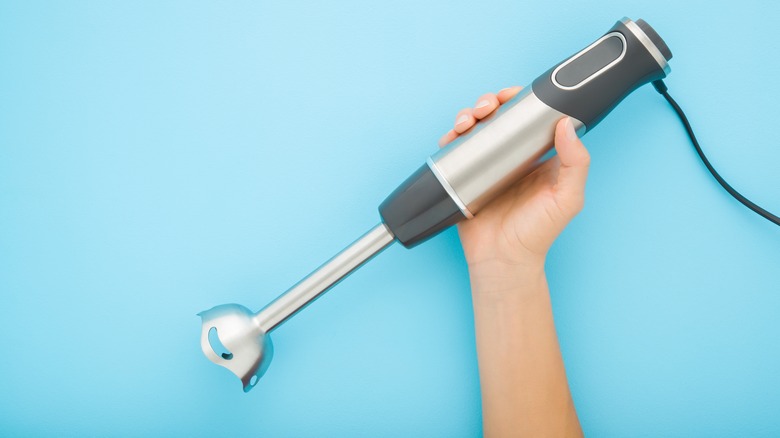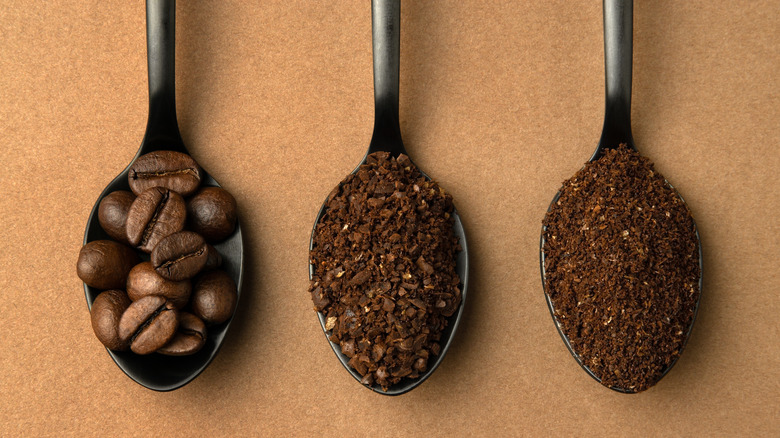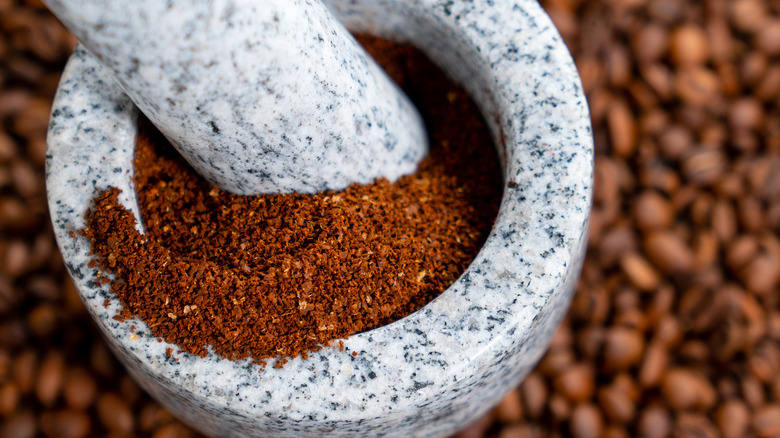Why You Should Never Use An Immersion Blender To Grind Coffee Beans
Believe it or not, grinding coffee beans at home doesn't always require a bulky appliance that's meant specifically for the job. You'll find that there are plenty of things already sitting in your kitchen that can come to the rescue — think food processors, a mortar and pestle, or even just a rolling pin. Though each gadget has pros and cons that are worth considering, one appliance that you should always stay away from, no matter how dire the situation, is an immersion blender.
The immersion blender method has become a popular hack making the rounds on TikTok. For this trick, you upturn the blender blade side up and pop a handful of beans into the curved basin before covering it in some plastic. Once you turn the blender on, you should have a fluffy powder of evenly ground beans in a jiffy — at least in theory.
Although it seems like a clever hack at first, there are several problems to consider. For one, there is the danger of using an immersion blender while it's upside down with the blades facing towards you. Blenders are not meant to be used this way, and it's entirely possible that the parts inside might not be as tightly secured as they should be and may fly off. There's also the risk of accidentally turning on the blender while you're working so close to the exposed blades and hurting your fingers — it's an entirely unnecessary and avoidable kitchen mishap.
Immersion blenders are not that effective for the task anyway
The obvious dangers of working with an overturned immersion blender aside, there's also the matter of the hack's effectiveness (or lack thereof) to consider. Using an immersion blender in this way can be incredibly messy. Although you'll cover the blades with plastic to hold the coffee beans inside as they grind, you'll have to seal them very tightly. The force of the blender will make the beans fly, so unless the plastic is wrapped well, they will quickly fall out.
Besides, the blades can easily rip through plastic. This can leave tiny fragments in your ground powder, which you might accidentally end up ingesting. There is also the fact that immersion blenders have small blades that are meant to puree and emulsify liquids rather than pulverize solids. While they are still sharp enough to chop things roughly, they don't have the best grinder settings for your coffee.
As a result, you will have uneven grounds, which will in turn lead to inconsistent flavor extraction. Larger and more coarse bits will leave sour notes in the java, whereas finer grounds will leave a bitter aftertaste, beating the entire point of grinding your own beans for more flavorful coffee in the first place! Some blenders can also generate a lot of heat, especially when they are used for long durations. Excessive heat will only alter the flavor of those delicately roasted coffee beans further.
Other, better ways to grind coffee beans at home
Using an immersion blender is even more futile when you consider other, more effective ways to blitz coffee beans at home. For instance, there's always a regular blender, which works much like a blade coffee grinder (as opposed to a burr one). While this also poses the risk of generating too much heat and impacting the flavor of the beans, it's a safer option than using an upturned immersion blender. Alternatively, you could even use a food processor, which will produce more even grounds than a blender. Manual food choppers are also an option, so as long as their blades are sturdy enough to cut through the brittle beans.
If such appliances are a no-go, consider crushing the beans in a mortar and pestle. The only downside is that it can be a laborious process and that you won't be able to grind more than a few beans at a time. However, crushing them by hand will also give you more control over how fine or coarse you want the grounds to be. You could even seal the beans in a plastic bag and smash them with a rolling pin, a pan, or any hard and heavy object. While you might find the grounds to be more coarse using this method, it's not always a bad thing. Brewing methods like the French press rely on grainier grounds anyway, so smashing the beans this way can absolutely work in a pinch.



